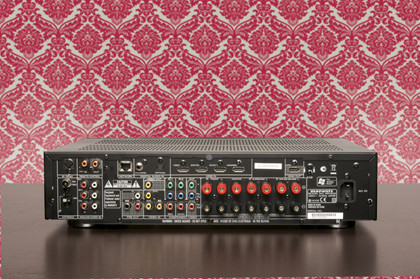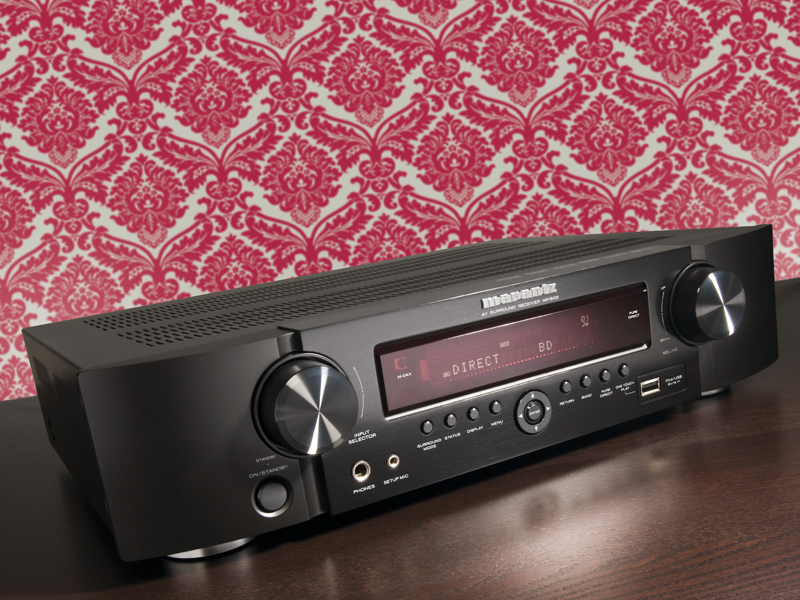TechRadar Verdict
Pros
- +
Rich, melodious character
- +
AirPlay and internet radio
- +
Good audio file compatibility
- +
Slick design
Cons
- -
Audyssey AutoEQ not always accurate
- -
Not a muscle amp
Why you can trust TechRadar
Whether through luck or design, Marantz has created something rather special with the NR1602.
Driven by a desire to innovate within the often stultifying constraints of hardcore AV, the company has taken the traditional hefty AVR form factor and chopped it in half. The result is a component with a good deal more va-va-voom than its peers.
But there's more to the NR1602 than downsizing. The brand has also rebalanced feature priorities. Network streaming, internet radio and AirPlay are as important to this AVR as multichannel audio. If you were to reboot the home theatre market tomorrow, the NR1602 would be the benchmark.
Signature livery
The machine has a distinctive, Marantz-flavoured fascia: all curved edges and fussy buttonry. It's also available in both black and 'silvergold', the latter harking back to an era of champagne-coloured separates, and I must say I approve.
Standing 105mm tall, this receiver is not much larger than a Blu-ray player. However, the NR1602 is a 7.1 model boasting solid connectivity and every key audio codec (Dolby TrueHD, DTS-HD Master Audio, DD Plus, DTS HD, plus DSX height/ width processing).

It has four 3D-compatible HDMI inputs (all with support for Audio Return Channel compatible gear), two component and three phono AV inputs, digital optical and coaxial audio inputs, plus Ethernet. There's also an accessory Marantz-eXtension Port for an optional Bluetooth receiver, enabling you to wirelessly stream from your Windows or Android mobile.
All speakers benefit from decent binding posts. Connectivity extends to the front with a USB input that doubles as both a digital iPod/iPhone connection and media reader.
The NR1602 is just as comfortable browsing external hard drives as large USB sticks. It certainly wasn't fazed by a full 160GB drive.
Hero GUI
The set-up routine is polished and painless. An easy-to-follow wizard guides you through the system configuration, speaker connections and room calibration.
The user interface on this AVR is terrific. It's high-res, fast and intuitive. Assigning inputs is particularly simple, thanks to a neat tabular layout. Why doesn't everyone do it this way? There's also a video overlay for volume and channel selection, still something of a rarity on HDMI kit.
The NR1602 comes with Audyssey's MultiEQ auto-calibration system. A supplied microphone plugs into the front of the AVR and, when prompted, issues a series of squawks to assess distance and level. It can take measurements from multiple seating positions (the 2EQ Full Calibration mode), or just one (Quick Start).
However, as I've found with previous Audyssey calibration systems, accuracy can be a little suspect; in this instance the unit miscalculated the relative distances of my rear speakers and subwoofer. Still, this is a simple fix. You can always forego auto-calibration entirely, manually setting distance and levels for yourself.
Audyssey's MultiEQ system comes saddled with Audyssey Dynamic EQ and Dynamic Volume technologies, neither of which I much care for. Dynamic Volume should be switched off immediately. Designed to smooth out the dynamic peaks in source material, it's of use only to those who don't like loud bangs. Like kittens.
Once on your LAN, this DLNA-savvy receiver quickly sniffs out other like-minded devices. It found my assorted uPnP and DLNA NAS devices instantly. The receiver also rocks a very nice internet radio implementation, and includes support for Last.FM, Napster and even Flickr, the photo-sharing site.
While there's an AM/FM receiver onboard, I can't see it getting much use when there are so many net music options. Not only is there a bigger universe of choice online, but quality is generally better, too.
As it happens, having Flickr on an AVR alongside 'net radio proves to be a wizard wheeze. While the NR1602 does have a screensaver to prevent image retention, letting it slideshow Flickr images is a great way to fill the visual void.
Streaming audio file compatibility is solid across LAN and from USB. The NR1602 has no problem with MP3, Ogg, WMA, WAV, FLAC and AAC files. It also correctly read artist and album metadata.
Of course, the centre of attraction for iTunes and iOS users will be the provision of AirPlay. It takes no time at all to set up, and you'll soon be streaming from either PC or Mac, or iOS device. As a user experience, AirPlay verges on the transformational. It's a very cool way to explore a music collection, especially via an iPad.
Steve has been writing about AV and home cinema since the dawn of time, or more accurately, since the glory days of VHS and Betamax. He has strong opinions on the latest TV technology, Hi-Fi and Blu-ray/media players, and likes nothing better than to crank up his ludicrously powerful home theatre system to binge-watch TV shows.

